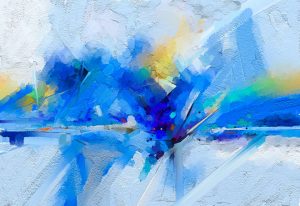Take a look at a work of art. What do you see? You likely notice characters, actions, and scenery, but if you look a little closer, you will notice movement, contrast, patterns, and balance. These are the elements of composition—various visual elements that make up a painting or drawing. They are not to be confused with the elements of art, which include lines, shapes, colors, values, etc.
There are 8 elements of composition in art and design, and they are as follows: 
- Balance focuses on the symmetry or asymmetry of a work of art. A symmetrical painting, for instance, will feel calm and balanced, while an asymmetrical painting will appear chaotic and unbalanced.
- Unity, or variety, asks how diverse or monotonous a particular work of art appears. In other words, do the objects of your painting or drawing fit together? Or does something seem out of place?
- Contrast is the difference or juxtaposition of various elements of art. You can have contrast between light and dark, circles and squares, or any other seemingly different elements.
- Focus, or emphasis, is as it sounds—it’s the focal point of your artwork. When someone views your painting, their eye will automatically gravitate towards a specific subject. That is the focal point.
- Pattern is the repetition of certain shapes, lines, colors, or elements. Practically anything can be turned into a pattern just as long as it repeats throughout the painting or drawing.
- Movement is the illusion or sense of motion (or lack thereof) throughout a piece of art. For example, a scarf blowing in the wind portrays movement, while a cup sitting on a table portrays stillness.
- Rhythm relies on movement, as it uses the sense of motion to create an organized repetition of artistic elements. It is often confused with pattern, but while patterns are consistent (the same shape over and over again), rhythm includes variety (different shapes repeated in a similar order). You can think of it as rhythm in music where there is a consistent, underlying beat but with various notes.
- Proportion is how different subjects or objects relate to one another. By using linear perspective, you can make objects appear large or small, nearby or distant.
Understanding the elements of composition in art and design is one way to elevate the quality of your artwork. To learn more about how to use these elements, sign up for a beginner’s art class here at Creative Ventures Gallery today!
